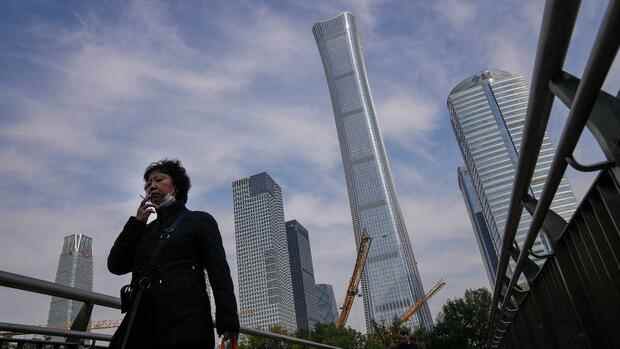Beijing China’s growth is cooling off: According to figures published on Monday by the National Statistics Office in Beijing, the economy of the People’s Republic only grew by 4.9 percent in the third quarter compared to the same period of the previous year and was thus slightly below expectations. Analysts had expected an average of at least five percent growth. In the previous quarter, the world’s second largest economy had grown by 7.9 percent.
Industrial production in particular weakened. In September it only grew by 3.1 percent year-on-year – and thus significantly more slowly than in August (5.3 percent). Analysts had expected an average increase of 4.5 percent.
Retail sales, which are an indicator of consumption, recovered somewhat more strongly than expected and grew by 4.4 percent year-on-year in September. However, the overall growth rate in retail sales is still low, writes Iris Pang, chief economist for Greater China at ING Bank, in an analysis. Analysts had expected an average of 3.3 percent. In the previous month, consumption had slumped from an increase of 8.5 percent in July to 2.5 percent in August.
Pang sees one reason for the development in the influence of political measures such as the closure of tutoring centers on employment, which had a negative impact on purchasing power. Measures to combat the corona pandemic would also have had an impact. In the previous month, consumption had slumped from an increase of 8.5 percent in July to 2.5 percent in August.
Top jobs of the day
Find the best jobs now and
be notified by email.
The overall slowdown in growth is not surprising, said Chen Long, a partner at Plenum, an analysis company based in Beijing that specializes in China, the Handelsblatt. The only thing that is going well at the moment is export.
Real estate crisis is holding back growth
In September, the official, state-recorded purchasing managers’ index (PMI) for the manufacturing sector in China had already slipped below the 50 mark, which indicates that sentiment has deteriorated. According to the National Statistics Office, the value was only 49.6 points.
The mood in China’s manufacturing industry last turned negative at the beginning of the corona crisis in February 2020. At that time, however, the official purchasing managers’ index had dropped significantly more to 35.7 points.
There are several reasons for the slower growth and generally clouded mood. One of the most important is the ongoing crisis in the real estate sector, an important pillar of China’s economy. Experts estimate that the industry contributes between a quarter and a third to economic output. In the past few months, however, several property developers have had problems making interest payments.
The most prominent example is the heavily indebted Evergrande group. The real estate developer’s debt is estimated to be at least $ 300 billion. Competitors such as Fantasia and Modern Land have also stumbled.
Additional pressure on property developers is causing reluctance among potential buyers. According to calculations by the financial news agency Bloomberg based on data from the National Statistics Office, house sales in terms of value fell by 16.9 percent in September compared to the previous year.
Power outages put a strain on companies
At a meeting of the Group of Thirty on Sunday, Yi Gang, head of the Chinese central bank PBOC (People’s Bank of China), admitted that the default risks of some companies and the operational difficulties of small and medium-sized banks pose challenges for the Chinese economy and that the authorities are keeping a watchful eye “that they do not become systematic risks”. The problems of the heavily indebted real estate developer Evergrande “are cause for concern,” said Yi, but assured: “Overall, we can contain the Evergrande risk”.
Large-scale power cuts, particularly in the economically strong south and north-east of the country, have also put a severe damper on the Chinese economy in recent months. Since August there has been a reduction in electricity supply in more than 20 provinces. At times, factories had to make do with a significantly lower amount of electricity for several hours or to close completely.
In addition, there are always isolated new outbreaks of corona cases in China. Since the Chinese government is pursuing a zero Covid strategy, it is always countering this at the local level with draconian measures, such as curfews and travel restrictions that last for weeks.
Experts do not expect the situation for the world’s second largest economy to ease in the coming months. The Chinese leadership has taken some measures at both the central and local levels to improve the electricity supply in the affected areas. Some coal mines were ordered to ramp up their production and the prices for electricity that producers were allowed to charge were at least partially liberalized.
No quick improvement in sight
But observers largely agree that the electricity supply will primarily benefit private households. The heating season will start in China in the coming weeks. The companies could continue to be left behind.
In October, the situation on the electricity market will probably be a little better than in September, believes Chen Long from Plenum, but the overall situation will not relax until July: “The situation in the real estate sector will probably continue to deteriorate.”
Chen certainly expects stimulating measures for the economy. “It is not a question of whether it will exist, but rather when and how,” says the analyst. You can already see minor adjustments to the policy. “But we’ll have to wait a few more months until the changes are big enough.”
Chang Shu, chief economist for Asia at Bloomberg, also believes that a rapid turnaround is unlikely. The economic slowdown is primarily due to supply shocks and the government has committed to long-term structural reforms.
More: US gas to China instead of Europe? According to insiders, China is aiming for a billion-dollar deal in the middle of the gas crisis
